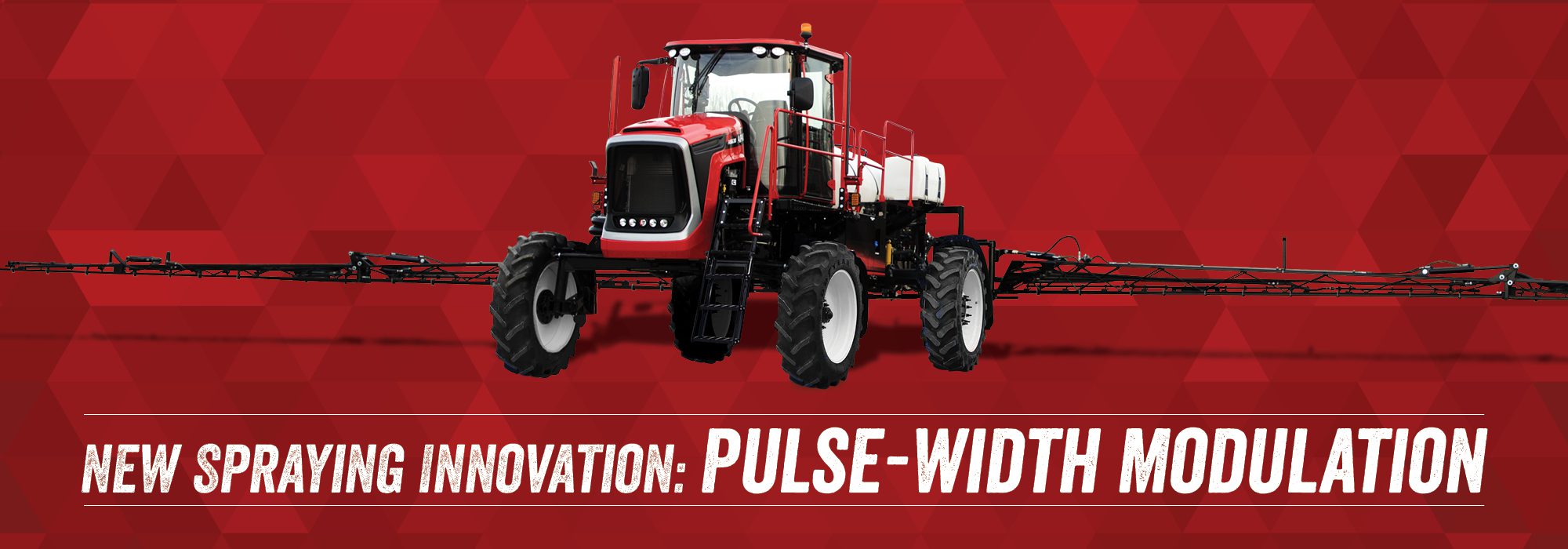Spray smarter, save money with pulse-width modulation
Spray drift continues to be a big issue for chemical applicators, and it has led to the rise of digital spraying technology that utilizes pulse-width modulation (PWM). The new sprayer innovation, available on every Apache Sprayer through the Raven HawkeyeTM system, helps operators more efficiently apply chemicals and sustain environmental and crop quality by preventing spray drift.
Why Use PWM
When facing windy or inclement conditions but a spraying job must be done, the operator typically has to slow down the sprayer and back off application pressure. This is needed to effectively deliver chemical where it needs to without wind catching, taking it elsewhere and inflict damage to other crops or plants. Today’s PWM helps operators sustain more consistent field operations at speeds close to, or at the same level as, optimal conditions.
Pulse-width modulation isn’t the newest technology in the world. Some manufacturers have been offering the functionality for more than a decade, but more recent advancements, spurred by increased scrutiny of the chemical application sector, have made new systems more functional and efficient in controlling drift. In the last five years alone, issues with drift and increasing overall chemical and crop input costs have amplified interest and demand for digital spraying and PWM.
How PWM Works
Pulse-width modulation, like that in the Raven Hawkeye system, uses solenoids at each spray tip that open and close a valve at the nozzle tip that “pulses.” The pulse of the valves’ opening is consistent, with the valve opening once every 1/10 of a second, and spray volume and droplets are applied based on percentages of the modulation’s “duty cycle.” A 25% duty cycle in a PWM system would result in a lighter application that would ordinarily require a low pressure. A 75% duty cycle, on the other hand, would mean a higher application rate.
“At a 25% modulation, you’re only going to have that valve open 25% of the time when the nozzle is pulsing, so you’re going to have a lower flow rate. At 75%, you’re going to be open during much more of that pulse, so you will be applying more,” said Tyler Gordon, Apache Sprayers Service Specialist. “Adjusting the percentage of the duty cycle is how you increase or decrease your flow rate, all the while keeping the same pressure.”
“We actually hook these solenoids up near the check valve on each nozzle. The fluid reaches that check valve at the nozzle, and we can control the flow with that solenoid. Now, when we want to shut off the fluid flow, like when we enter an area that’s already been applied, we can instantly turn off some of the nozzles,” Gordon said. “You basically have 40 pounds of pressure at the nozzle tip at all times.”
Benefits of PWM
1. Consistent pressure
Through a sequence of valves constantly opening and closing, the system maintains more consistent pressure and makes adjustments via a central in-cab monitor based on operator adjustments accounting for weather conditions and map inputs. The system can also provide per-nozzle control, preventing spray overlap and allowing a higher level of application precision, and PWM allows more precise control of droplets even when running at ground speeds that would ordinarily prevent the required pressure from building to adequate levels for the chemical to reach its target plants.
2. More precision and flexibility
Pulse-width modulation makes it possible to eliminate the “run-down time” associated with conventional spray booms and nozzles, adding precision to the spraying process. It also provides operational flexibility, allowing the operator to spray at different speeds but maintaining the same coverage when conditions would otherwise keep the sprayer parked. Most importantly, it helps prevent spray drift since the pulse-width modulation helps better deliver chemical in a wider array of conditions – namely wind – without adjusting speeds or changing components. That, in turn, makes spraying operations more consistent and efficient by eliminating two factors that can add to overall spraying operations and their efficacy.
“If I want to spray at 30 PSI, PWM allows me to run anywhere from 8 to 16 MPH with the same nozzle tips and the pressure going through those tips will create the droplet sizes I need. It’s changing that duty cycle to hold 30 pounds of pressure at a wider range of ground speeds,” Gordon said. “The pressure going through that tip is what creates the droplet size of the chemical. Now, I can maximize my chemical applications by yielding a 500-micron droplet size more consistently, for example. The higher the droplet size, the more drift you might get.”
3. Spray no matter what the weather conditions
That’s the primary benefit of pulse-width modulation. It helps the operator avoid spray drift by applying larger droplet sizes more consistently – and at a wider range of speeds – through the adjustment percentages in the pulse-width modulation system, not the actual overall system pressure itself. But, that’s not the end of its benefits. It also allows the operator to spray in conditions that might otherwise prevent it because of wind or other issues that influence drift and sprayer ground speeds.
“Depending on the application, most operators are spraying at 40 pounds of pressure or so. If you get over a 10 MPH wind, most can’t spray or they have to slow way down,” Gordon said. “But with this system, you can turn pressure down to 20 PSI and reduce drift yet continue to spray at the same speed.”
Specifics of the Raven Hawkeye
Other benefits come in the design of the Raven Hawkeye system. Because it manages sprayer booms in sections, the system creates up to 16 “virtual boom sections” that help precisely manage applications by providing shutoff capabilities through the solenoids and valves that otherwise manage each tip’s pulse modulation.
“A lot of farmers who operate a lot of large, square fields don’t think that they need that level of precision, and they may not need that level of precision. But, if you don’t farm a single square field, you can see up to a 15% savings on chemical,” Gordon said. “If you add that up over the five-year average life of a sprayer, that could be thousands of dollars in chemical savings. That’s what I have heard from farmers who have operated the Raven Hawkeye system for a year.”
Those cost savings are likely to be a mainstay on operations utilizing PWM, especially as Apache Sprayers continue integrating more technology as it develops in the future. In the end, it will remain critical for farmers to focus on connecting their uptake of new tools like pulse-width modulation with overall operational efficiency.
“The bottom line is it comes down to dollars and cents,” Gordon said. “You almost always know, in the ballpark, how many bushels of corn or soybeans you’re going to get out of your fields every year. It just always comes down to reducing input costs and making your spraying operations more efficient is one way to do it.”
Looking to upgrade your sprayer precision? Find out more about Raven Hawkeye and other precision options with Apache Sprayers.



